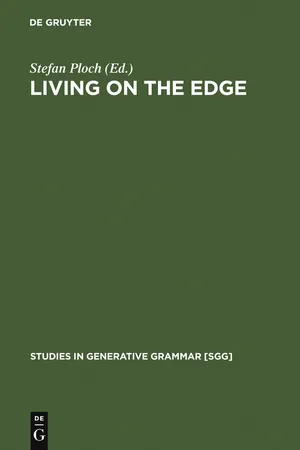
This is a test
- 747 pages
- English
- PDF
- Available on iOS & Android
eBook - PDF
Living on the Edge
Book details
Table of contents
Citations
About This Book
The architecture of the human language faculty has been one of the main foci of the linguistic research of the last half century. This branch of linguistics, broadly known as Generative Grammar, is concerned with the formulation of explanatory formal accounts of linguistic phenomena with the ulterior goal of gaining insight into the properties of the 'language organ'. The series comprises high quality monographs and collected volumes that address such issues. The topics in this series range from phonology to semantics, from syntax to information structure, from mathematical linguistics to studies of the lexicon.
Frequently asked questions
At the moment all of our mobile-responsive ePub books are available to download via the app. Most of our PDFs are also available to download and we're working on making the final remaining ones downloadable now. Learn more here.
Both plans give you full access to the library and all of Perlego’s features. The only differences are the price and subscription period: With the annual plan you’ll save around 30% compared to 12 months on the monthly plan.
We are an online textbook subscription service, where you can get access to an entire online library for less than the price of a single book per month. With over 1 million books across 1000+ topics, we’ve got you covered! Learn more here.
Look out for the read-aloud symbol on your next book to see if you can listen to it. The read-aloud tool reads text aloud for you, highlighting the text as it is being read. You can pause it, speed it up and slow it down. Learn more here.
Yes, you can access Living on the Edge by Stefan Ploch, Stefan Ploch in PDF and/or ePUB format, as well as other popular books in Languages & Linguistics & Linguistics. We have over one million books available in our catalogue for you to explore.
Information
Table of contents
- Preface
- Curriculum vitae
- Testimonials
- Publications
- Instead of an introduction
- 1 General issues
- 1.1. Acquisition
- Meno’s paradox and the acquisition of grammar
- On the logical order of development in acquiring prosodic structure
- 1.2. Computation
- On the computability of certain derivations in Government Phonology
- 1.3. The organisation of grammar
- Structure paradoxes in phonology
- An x-bar theory of Government Phonology
- 1.4. Philosophy of science and metatheory
- Meta-phonological speculations
- Metatheoretical problems in phonology with Occam’s Razor and non-ad-hoc-ness
- 2 Elements: segmental structure and processes
- Eerati tone: towards a tonal dialectology of Emakhuwa
- Government Phonology and the vowel harmonies of Natal Portuguese and Yoruba
- Palatalisation in Brazilian Portuguese
- Two notes on laryngeal licensing
- On spirantisation and affricates
- 3 Structure
- 3.1. Branching onsets
- Branching onsets in Polish
- Are there branching onsets in Modern Icelandic?
- Remarks on mutæ cum liquidā and branching onsets
- Defective syllables: the other story of Italian sC(C)-sequences
- 3.2. “Codas”
- Remarks on prenominal liaison consonants in French
- The phonotactics of a “Prince” language: a case study
- On the syllabification of right-edge consonants – evidence from Ahtna (Athapaskan)
- Licensing constraint to let
- 3.3. Empty categories
- Empty and pseudo-empty categories
- Unlicensed domain-final empty nuclei in Korean
- Unreleasing: the case of neutralisation in Korean
- 3.4. “Syllabic consonants”
- /r/ syllabicity: Polish versus Bulgarian and Serbo-Croatian
- The syllabic nasal in Japanese
- 3.5. Templates and morphology
- Template and morphology in Khalkha Mongolian – and beyond?
- A non-derivational analysis of the so-called “diminutive retroflex suffixation”
- Why Arabic guttural assimilation is not a phonological process
- 5.6. Metrical structure
- On a certain notion of “occurrence”: the source of metrical structure, and of much more
- References
- Subject index
- Language index
- Names index
- Contributors